Mapping Global Research Landscapes of Acupuncture for Diabetes Mellitus: A 20-Year Bibliometric Study (2004–2024)
Abstract
1. Introduction
2. Materials and Methods
2.1. Data Source and Search Strategy
2.2. Data Collection and Analysis
3. Results
3.1. Analysis of Publications
3.2. Analysis of Countries/Regions
3.3. Analysis of Major Institutions
3.4. Analysis of Authors and Co-Cited Authors Analysis
3.5. Analysis of Journals and Co-Cited Journals Analysis
3.6. Analysis of Co-Cited References and Reference Burst
3.7. Analysis of Frontiers and Hotspots
4. Discussion
4.1. General Information
4.2. Hot Topics and Frontiers
5. Strengths and Limitations
6. Conclusions
Author Contributions
Funding
Institutional Review Board Statement
Informed Consent Statement
Data Availability Statement
Conflicts of Interest
Abbreviations
| DPN | Diabetic peripheral neuropathy |
| FBG | Fasting blood glucose |
| GRP78 | Glucose-regulated protein 78 |
| HbA1c | Glycated hemoglobin |
| HOMA-IR | Homeostasis model assessment of insulin resistance |
| IDF | International Diabetes Federation |
| MeSH | Medical Subject Headings |
| RCTs | Randomized controlled trials |
| T2DM | Type 2 diabetes mellitus |
| TCM | Traditional Chinese Medicine |
| USA | the United States |
| WOSCC | Web of Science Core Collection |
References
- Tong, X.L.; Jia, W.P.; Wang, X.G.; Yang, S.Y.; Ni, Q.; Li, M. Guidelines for Diagnosis and Treatment of Type 2 Diabetes Mellitus with Integrated Traditional and Western Medicine. Jilin Tradit. Chin. Med. 2024, 44, 1117–1127. [Google Scholar] [CrossRef]
- Gao, D.H.; Yuan, A.H.; Wang, Y.G.; Huang, H.Y.; Zhang, Q.P. Acupuncture Treatment of Type 2 Diabetes and Complications of the Experimental Research Progress. J. Heilongjiang Chin. Med. 2013, 42, 40–42. [Google Scholar] [CrossRef]
- Shen, G.G.; Zhou, J.; Chen, Y.Y.; Zhang, W.Q.; Cheng, Y.; Lin, J.; Xiao, X.M. Study on the Correlation between Serum Uric Acid and Diabetic Peripheral Neuropathy in Patients with Type 2 Diabetes Mellitus. Chin. J. Diabetes 2023, 31, 764–768. [Google Scholar] [CrossRef]
- Sun, H.; Saeedi, P.; Karuranga, S.; Pinkepank, M.; Ogurtsova, K.; Duncan, B.B.; Stein, C.; Basit, A.; Chan, J.C.N.; Mbanya, J.C.; et al. IDF Diabetes Atlas: Global, Regional and Country-level Diabetes Prevalence Estimates for 2021 and Projections for 2045. Diabetes Res. Clin. Pract. 2022, 183, 109119. [Google Scholar] [CrossRef]
- Forbes, J.M.; Cooper, M.E. Mechanisms of Diabetic Complications. Physiol. Rev. 2013, 93, 137–188. [Google Scholar] [CrossRef] [PubMed]
- Lian, F.M.; Ni, Q.; Shen, Y.D.; Yang, S.Y.; Piao, C.L.; Wang, J.; Wei, J.P.; Duan, J.G.; Fang, Z.H.; Lu, H.; et al. International Traditional Chinese Medicine Guideline for Diagnostic and Treatment Principles of Diabetes. Ann. Palliat. Med. 2020, 9, 2237–2250. [Google Scholar] [CrossRef] [PubMed]
- Zhang, B.X.; Zhou, L.J.; Chen, K.Y.; Fang, X.Y.; Li, Q.W.; Gao, Z.Z.; Lian, F.M.; Li, M.; Tian, J.X.; Zhao, L.H.; et al. Investigation on Phenomics of Traditional Chinese Medicine from the Diabetes. Phenomics 2024, 4, 257–268. [Google Scholar] [CrossRef]
- Meng, X.L.; Liu, X.Q.; Tan, J.Y.; Sheng, Q.; Zhang, D.B.; Li, B.; Zhang, J.; Zhang, F.Y.; Chen, H.Z.; Cui, T.; et al. From Xiaoke to Diabetes Mellitus: A Rreview of the Rresearch Progress in Ttraditional Chinese Mmedicine for Ddiabetes Mmellitus Ttreatment. Chin. Med. 2023, 18, 75. [Google Scholar] [CrossRef]
- Chen, C.; Liu, J.; Sun, M.X.; Liu, W.H.; Han, J.; Wang, H.C. Acupuncture for Type 2 Diabetes Mellitus: A Systematic Review and Meta-analysis of Randomized Controlled Trials. Complement. Ther. Clin. Pract. 2019, 36, 100–112. [Google Scholar] [CrossRef]
- Zhuang, S.T.; Liu, S.Y.; Li, R.; Duan, H.R. Electroacupuncture Alleviates Insulin Resistance and Impacts the Hypothalamic IRS-1/PI3K/AKT Pathway and miRNA-29a-3p in a Rat Model of type 2 Diabetes. Acupunct. Med. 2025, 43, 104–113. [Google Scholar] [CrossRef]
- Guo, Y.H.; Zhang, L.Y.; Li, M.Y.; Lin, L.N.; Xue, F.Y.; Gao, W.N.; Xu, X.R.; Huang, H.P. Metabolomics of Mice with Type 2 Diabetes and Nonalcoholic Fatty Liver Treated by Acupuncture. Int. J. Endocrinol. 2024, 2024, 5568337. [Google Scholar] [CrossRef]
- Zhu, Y.; Tian, J.; Wei, X.L.; Jia, S.H.; Shu, Q. Electroacupuncture Alleviates Obesity and Insulin Resistance via the GLP-1-VTADA Reward Circuit. Neuroendocrinology 2024, 114, 263–278. [Google Scholar] [CrossRef] [PubMed]
- Xu, J.; Pei, J.; Fu, Q.H.; Wang, L.Y.; Zhan, Y.J.; Tao, L. Earlier Acupuncture Enhancing Long-Term Effects on Motor Dysfunction in Acute Ischemic Stroke: Retrospective Cohort Study. Am. J. Chin. Med. 2020, 48, 1787–1802. [Google Scholar] [CrossRef] [PubMed]
- Synnestvedt, M.B.; Chen, C.; Holmes, J.H. CiteSpace II: Visualization and Knowledge Discovery in Bibliographic Databases. AMIA Annu. Symp. Proc. 2005, 2005, 724–728. [Google Scholar] [PubMed]
- Chen, C.M.; Dubin, R.; Kim, M.C. Emerging Trends and New Developments in Regenerative Medicine: A Scientometric Update (2000–2014). Expert. Opin. Biol. Ther. 2014, 14, 1295–1317. [Google Scholar] [CrossRef]
- Cho, N.H.; Shaw, J.E.; Karuranga, S.; Huang, Y.; da Rocha Fernandes, J.D.; Ohlrogge, A.W.; Malanda, B. IDF Diabetes Atlas: Global Estimates of Diabetes Prevalence for 2017 and Projections for 2045. Diabetes Res. Clin. Pract. 2018, 138, 271–281. [Google Scholar] [CrossRef]
- Dimitrova, A.; Murchison, C.; Oken, B. Acupuncture for the Treatment of Peripheral Neuropathy: A Systematic Review and Meta-Analysis. J. Altern. Complement. Med. 2017, 23, 164–179. [Google Scholar] [CrossRef]
- Bailey, A.; Wingard, D.; Allison, M.; Summers, P.; Calac, D. Acupuncture Treatment of Diabetic Peripheral Neuropathy in an American Indian Community. J. Acupunct. Meridian Stud. 2017, 10, 90–95. [Google Scholar] [CrossRef]
- Pan, H.; Huang, H.P.; Zhang, L.Y.; Ma, S.Q.; Yang, H.M.; Wang, H.F. “Adjusting Internal Organs and Dredging Channel” Electroacupuncture Treatment Prevents the Development of Diabetic Peripheral Neuropathy by Downregulating Glucose-related Protein 78 (GRP78) and Caspase-12 in Streptozotocin-diabetic Rats. J. Diabetes 2019, 11, 928–937. [Google Scholar] [CrossRef]
- Feng, Y.Y.; Fang, Y.C.; Wang, Y.Q.; Hao, Y.M. Acupoint Therapy on Diabetes Mellitus and Its Common Chronic Complications: A Review of Its Mechanisms. BioMed Res. Int. 2018, 2018, 3128378. [Google Scholar] [CrossRef]
- Meyer-Hamme, G.; Friedemann, T.; Greten, H.J.; Plaetke, R.; Gerloff, C.; Schroeder, S. ACUDIN—ACUpuncture and Laser Acupuncture for Treatment of DIabetic Peripheral Neuropathy: A Randomized, Placebo-controlled, Partially Double-blinded Trial. BMC Neurol. 2018, 18, 40. [Google Scholar] [CrossRef]
- Meyer-Hamme, G.; Friedemann, T.; Greten, J.; Gerloff, C.; Schroeder, S. Electrophysiologically Verified Effects of Acupuncture on Diabetic Peripheral Neuropathy in Type 2 Diabetes: The Randomized, Partially Double-blinded, Controlled ACUDIN Trial. J. Diabetes 2021, 13, 469–481. [Google Scholar] [CrossRef] [PubMed]
- Wang, X.; Li, Q.; Han, X.; Gong, M.R.; Yu, Z.; Xu, B. Electroacupuncture Alleviates Diabetic Peripheral Neuropathy by Regulating Glycolipid-Related GLO/AGEs/RAGE Axis. Front. Endocrinol. 2021, 12, 655591. [Google Scholar] [CrossRef] [PubMed]
- Chang, S.L.; Lin, K.J.; Lin, R.T.; Hung, P.H.; Lin, J.G.; Cheng, J.T. Enhanced Insulin Sensitivity Using Electroacupuncture on Bilateral Zusanli Acupoints (ST 36) in Rats. Life Sci. 2006, 79, 967–971. [Google Scholar] [CrossRef] [PubMed]
- Wang, C.P.; Kao, C.H.; Chen, W.K.; Lo, W.Y.; Hsieh, C.L. A Single-blinded, Randomized Pilot Study Evaluating Effects of Electroacupuncture in Diabetic Patients with Symptoms Suggestive of Gastroparesis. J. Altern. Complement. Med. 2008, 14, 833–839. [Google Scholar] [CrossRef]
- Mannerås, L.; Jonsdottir, I.H.; Holmäng, A.; Lönn, M.; Stener-Victorin, E. Low-frequency Electro-acupuncture and Physical Exercise Improve Metabolic Disturbances and Modulate Gene Expression in Adipose Tissue in Rats with Dihydrotestosterone-induced Polycystic Ovary Syndrome. Endocrinology 2008, 149, 3559–3568. [Google Scholar] [CrossRef]
- Yin, J.; Chen, J.D. Gastrointestinal Motility Disorders and Acupuncture. Auton Neurosci. 2010, 157, 31–37. [Google Scholar] [CrossRef]
- Nash, J.; Armour, M.; Penkala, S. Acupuncture for the Treatment of Lower Limb Diabetic Peripheral Neuropathy: A Systematic Review. Acupunct. Med. 2019, 37, 3–15. [Google Scholar] [CrossRef]
- Shin, K.M.; Lee, S.; Lee, E.Y.; Kim, C.H.; Kang, J.W.; Lee, C.K.; Seo, B.N.; Kim, A.R.; Jung, S.Y.; Kwon, O.; et al. Electroacupuncture for Painful Diabetic Peripheral Neuropathy: A Multicenter, Randomized, Assessor-Blinded, Controlled Trial. Diabetes Care. 2018, 41, e141–e142. [Google Scholar] [CrossRef]
- Wu, C.; Li, Y.D.; Piao, C.L.; Wu, J.R. Effectiveness of Acupuncture for Diabetic Nephropathy: A Systematic Review and Meta-Analysis of Randomized Controlled Trials. Iran. J. Public Health 2024, 53, 2404–2418. [Google Scholar] [CrossRef]
- Liu, R.M.; He, M.; Zhao, X.W.; Sun, M.M.; Cao, J.Z.; Wang, X.Y.; Wang, X.B.; Zhao, S.M.; Wang, F.C.; Li, T. Effects of Stimulating Single Acupoint and Combination Acupoints on Diabetic Gastroparesis: A Randomised Controlled Trial Study. J. Tradit. Complement. Med. 2024, 14, 446–455. [Google Scholar] [CrossRef]
- Ma, S.Q.; Huang, H.P.; Xue, F.Y.; Wang, Q.; Yu, S.; Hou, Q.Y.; Li, M.Y.; Wang, H.F. Acupoint Prescriptions, Treatment Protocol and Outcome Evidence for Acupuncture in Diabetic Peripheral Neuropathy: A Scoping Review of Clinical Studies. Eur. J. Integr. Med. 2024, 70, 102376. [Google Scholar] [CrossRef]
- Yu, Z.Y.; Zhang, W.F.; Li, B.R.; Bao, P.J.; Wang, F.Y.; Sun, J.; Song, G.J.; Yin, L.; Nan, Z. Efficacy and Safety of Acupuncture Combined with Chinese Herbal Medicine for Diabetic Nephropathy: A Protocol for Systematic Review and Meta-analysis. Medicine 2021, 100, e27087. [Google Scholar] [CrossRef] [PubMed]
- Li, X.F.; Wang, H.R.; Zhou, X.; Ma, D.Y.; Chai, J.P.; Liu, J.Y.; Qian, X.; Chen, C.H.; Chen, X.H. Acupuncture combine with Tuina for diabetic peripheral neuropathy. Medicine 2021, 100, e28042. [Google Scholar] [CrossRef] [PubMed]
- Li, M.Y.; Yao, L.; Huang, H.P.; Zheng, H.Z.; Cao, J.Z.; Wang, G.; Liu, Y.Z.; Wang, H.F. Study on Acupuncture in the Treatment of Painful Diabetic Peripheral Neuropathy based on Rs-fMRI: A Protocol for Systematic Review and Meta-analysis. BMJ Open 2021, 11, e055874. [Google Scholar] [CrossRef] [PubMed]
- Yu, B.; Sun, M.M.; Wang, Z.H.; Zhu, B.; Xue, J.Q.; Yang, W.J.; Gao, X.Y.; Zhi, M.J.; Cao, J.Z.; Zhao, J.Y.; et al. Effects of Stimulating Local and Distal Acupoints on Diabetic Gastroparesis: A New Insight in Revealing Acupuncture Therapeutics. Am. J. Chin. Med. 2021, 49, 1151–1164. [Google Scholar] [CrossRef]
- Association, D.B.o.C.M. Chinese guidelines for the Prevention and Treatment of Type 2 Diabetes Mellitus (2020 edition) (Part 2). Chin. J. Pract. Intern. Med. 2021, 41, 757–784. [Google Scholar] [CrossRef]
- Zeng, Z.Y.; Li, Y.Y. Effects of Electroacupuncture at Weiwanxiashu and Zusanli Points on Blood Glucose and Plasma Pancreatic Glucagon Contents in Diabetic Rabbits. J. Tradit. Chin. Med. 2002, 22, 134–136. [Google Scholar]
- Šimat, M.; Janković Makek, M.; Mičetić, M. Treatment of Diabetes Mellitus by Acupuncture: Dynamics of Blood Glucose Level and Its Mathematical Modelling. Sci 2023, 5, 38. [Google Scholar] [CrossRef]
- Belivani, M.; Lundeberg, T.; Cummings, M.; Dimitroula, C.; Belivani, N.; Vasilakos, D.; Hatzitolios, A. Immediate Eeffect of Three Different Electroacupuncture Protocols on Fasting Blood Glucose in Obese Patients: A Pilot Study. Acupunct. Med. 2015, 33, 110–114. [Google Scholar] [CrossRef]
- Firouzjaei, A.; Li, G.C.; Wang, N.; Liu, W.X.; Zhu, B.M. Comparative Evaluation of the Therapeutic Effect of Metformin Monotherapy with Metformin and Acupuncture Combined Therapy on Weight Loss and Insulin Sensitivity in Diabetic Patients. Nutr. Diabetes 2016, 6, e209. [Google Scholar] [CrossRef]
- Xu, J.; Chen, L.; Tang, L.W.; Chang, L.; Liu, S.; Tan, J.F.; Chen, Y.L.; Ren, Y.L.; Liang, F.R.; Cui, J. Electroacupuncture Inhibits Weight Gain in Diet-induced Obese Rats by Activating Hypothalamic LKB1-AMPK Signaling. BMC Complement. Altern. Med. 2015, 15, 147. [Google Scholar] [CrossRef]
- Wang, Y.; Xu, G.N.; Wan, R.H.; Zhou, X.; Ma, L.Y.; Liu, B.; Zhang, Y.Y.; Zhou, L. Acupuncture in Treating Obesity Combined with Type 2 Diabetes Mellitus: A Systematic Review and Meta-analysis of Randomized Controlled Clinical Trials. Complement. Ther. Clin. Pract. 2022, 49, 101658. [Google Scholar] [CrossRef] [PubMed]
- Yu, B.; Li, M.Y.; Huang, H.P.; Ma, S.Q.; Huang, K.; Zhong, Z.; Yu, S.; Zhang, L.Y. Acupuncture Treatment of Diabetic Peripheral Neuropathy: An Overview of Systematic Reviews. J. Clin. Pharm. Ther. 2021, 46, 585–598. [Google Scholar] [CrossRef] [PubMed]
- Jung, H.J.; Won, T.N.; Kim, G.Y.; Jang, J.W.; Yeo, S.J.; Lim, S. Efficacy of Acupuncture on Cardiovascular Complications in Patients with Diabetes Mellitus in Korea: A Nationwide Retrospective Cohort. J. Integr. Med. 2023, 21, 176–183. [Google Scholar] [CrossRef] [PubMed]
- Zhai, Y.K.; Yu, W.J.; Shen, W. Diffusion Tensor Imaging Evaluates Effects of Acupoint Injection at Zusanli (ST36) for Type 2 Diabetic Peripheral Neuropathy. Med. Sci. Monit. 2022, 28, e935979. [Google Scholar] [CrossRef]
- Zhang, Y.T.; Wu, C.X.; Jiang, W.Q.; Cao, Y.; Chen, D.T. VGLUT2 and APP Family: Unraveling the Neurobiochemical Mechanisms of Neurostimulation Therapy to STZ-induced Diabetes and Neuropathy. Front. Endocrinol. 2024, 15, 1336854. [Google Scholar] [CrossRef]
- Pan, T.; Li, X.F.; Guo, X.L.; Wang, H.L.; Zhou, X.; Shang, R.; Xie, D.; Qian, X.; Dai, M.Y.; Fan, E.S.; et al. Electroacupuncture Improves Insulin Resistance in Type 2 Diabetes Mice by Regulating Intestinal Flora and Bile Acid. Diabetes Metab. Syndr. Obes. 2023, 16, 4025–4042. [Google Scholar] [CrossRef]

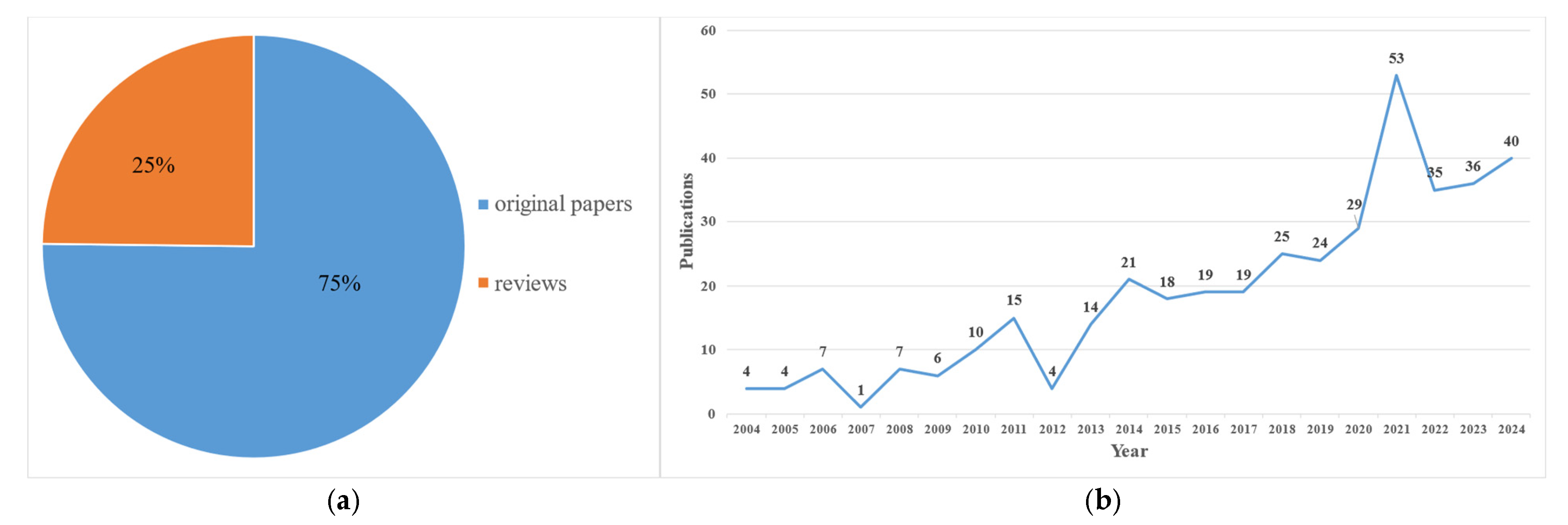
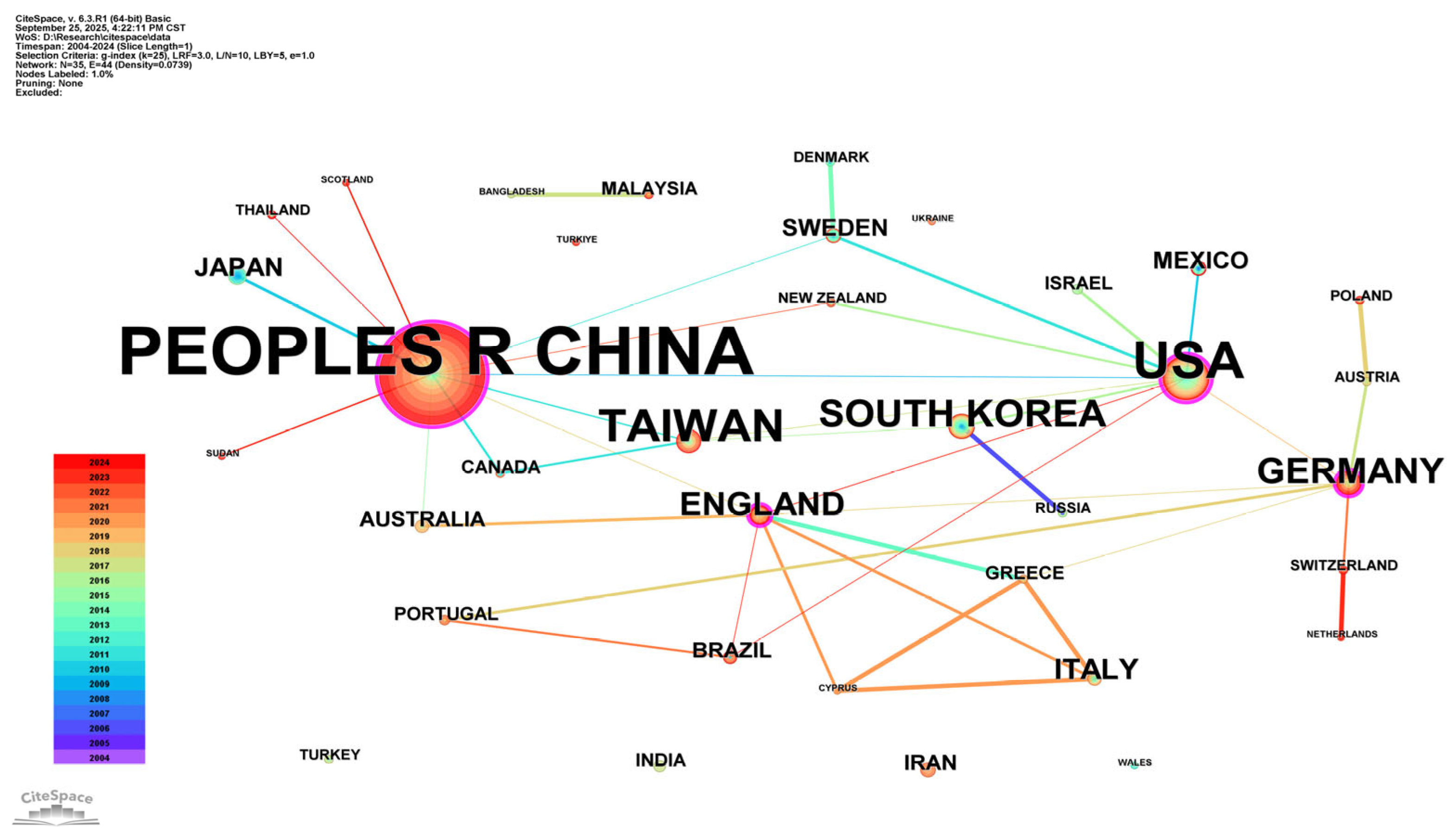
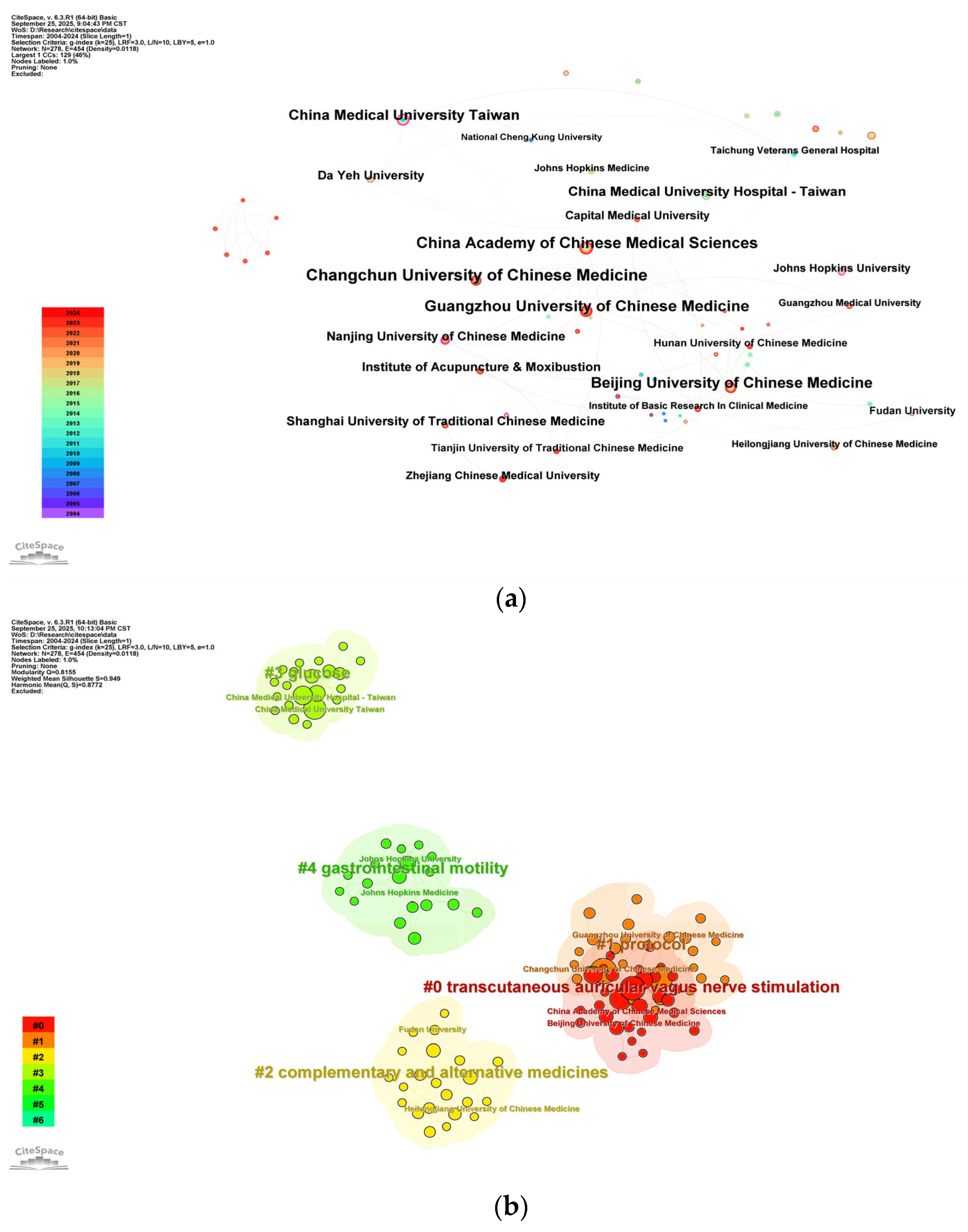
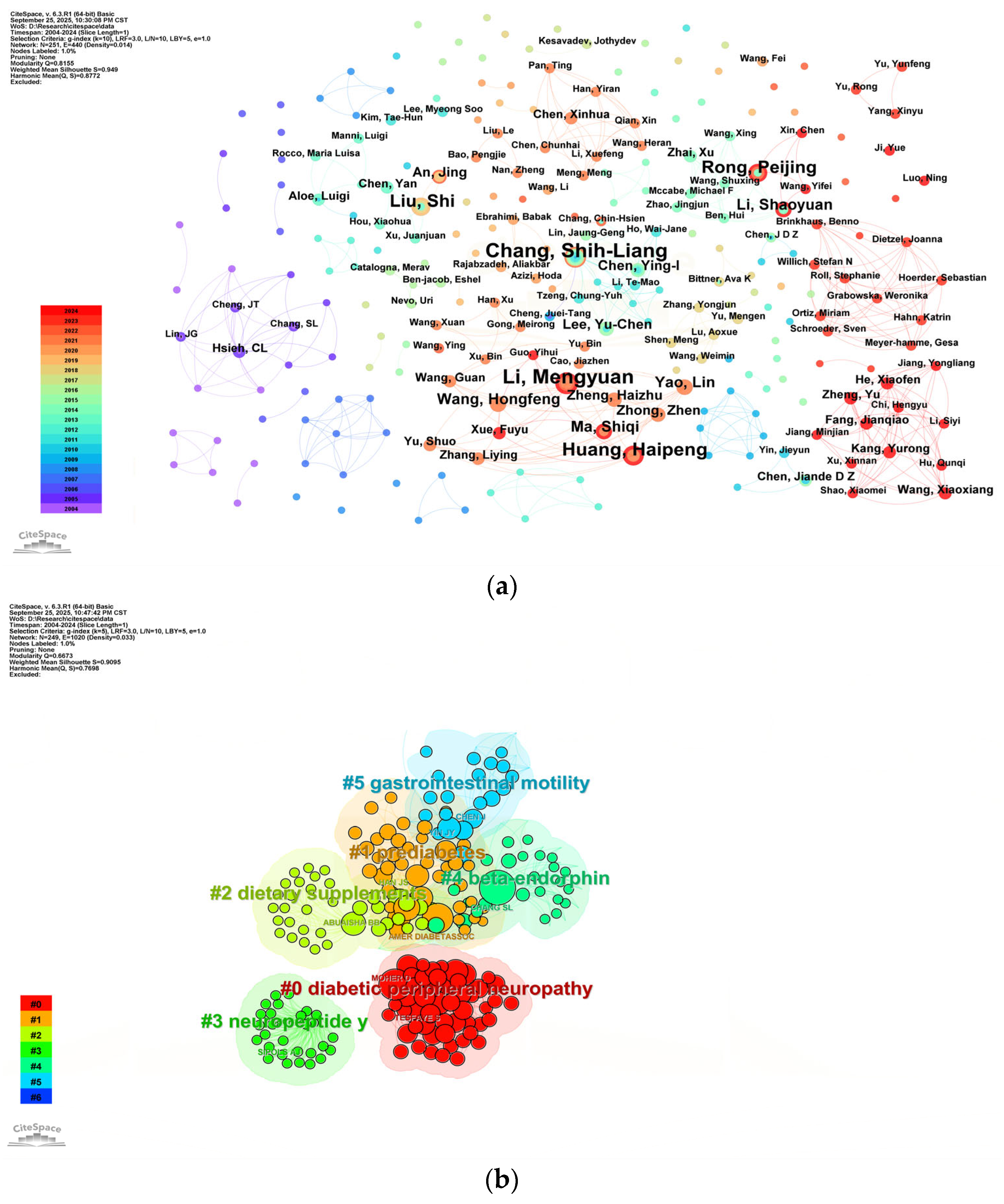
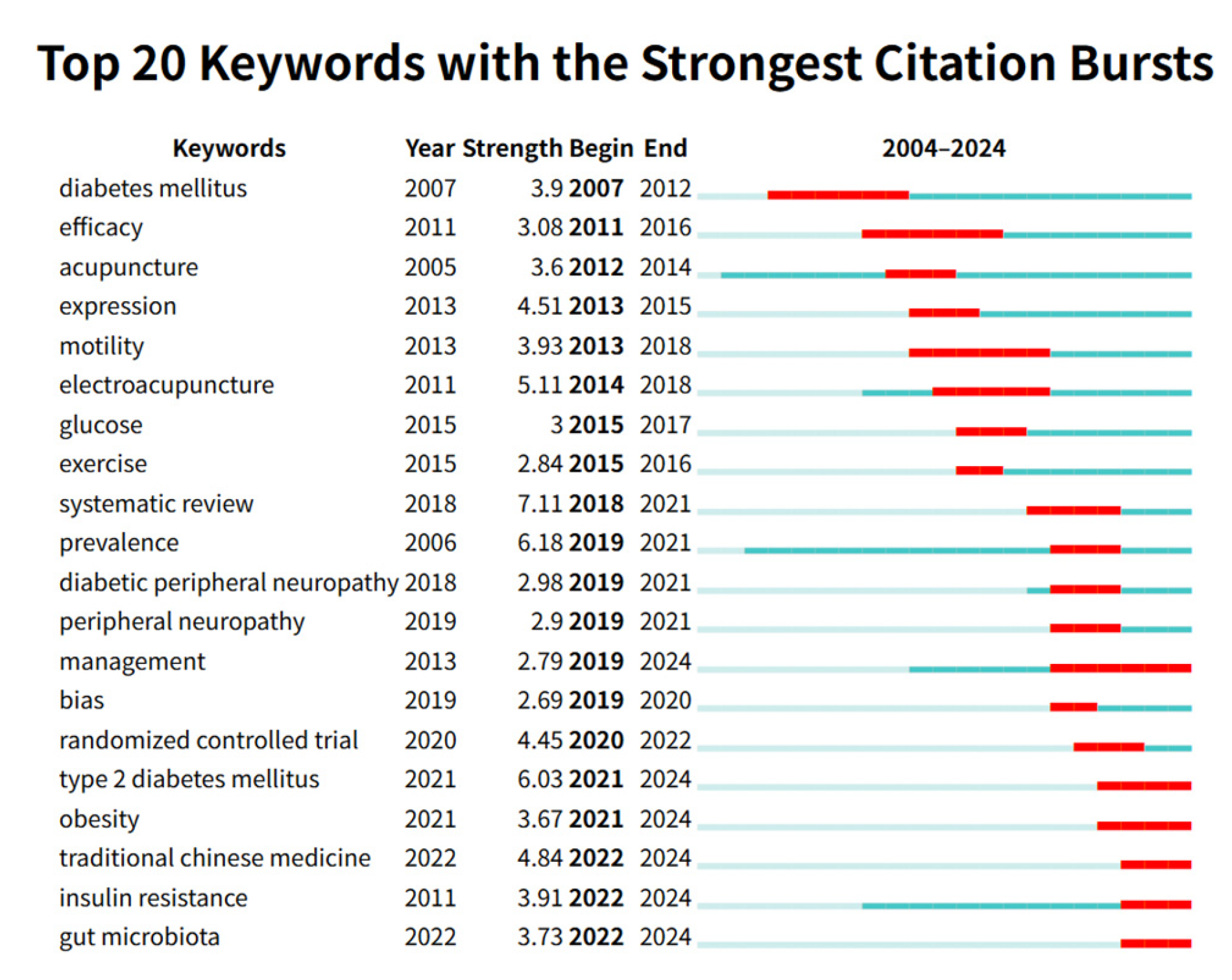
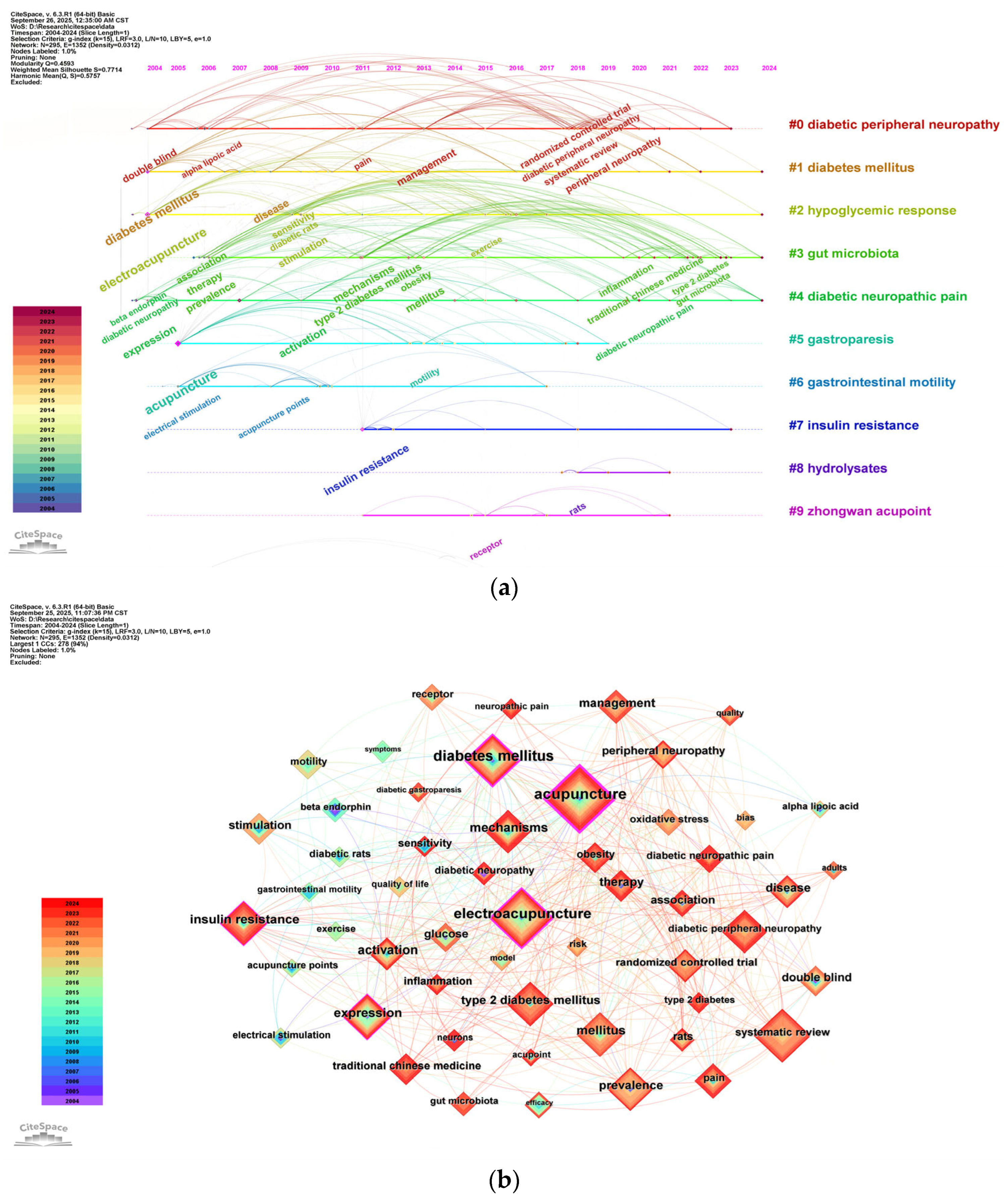
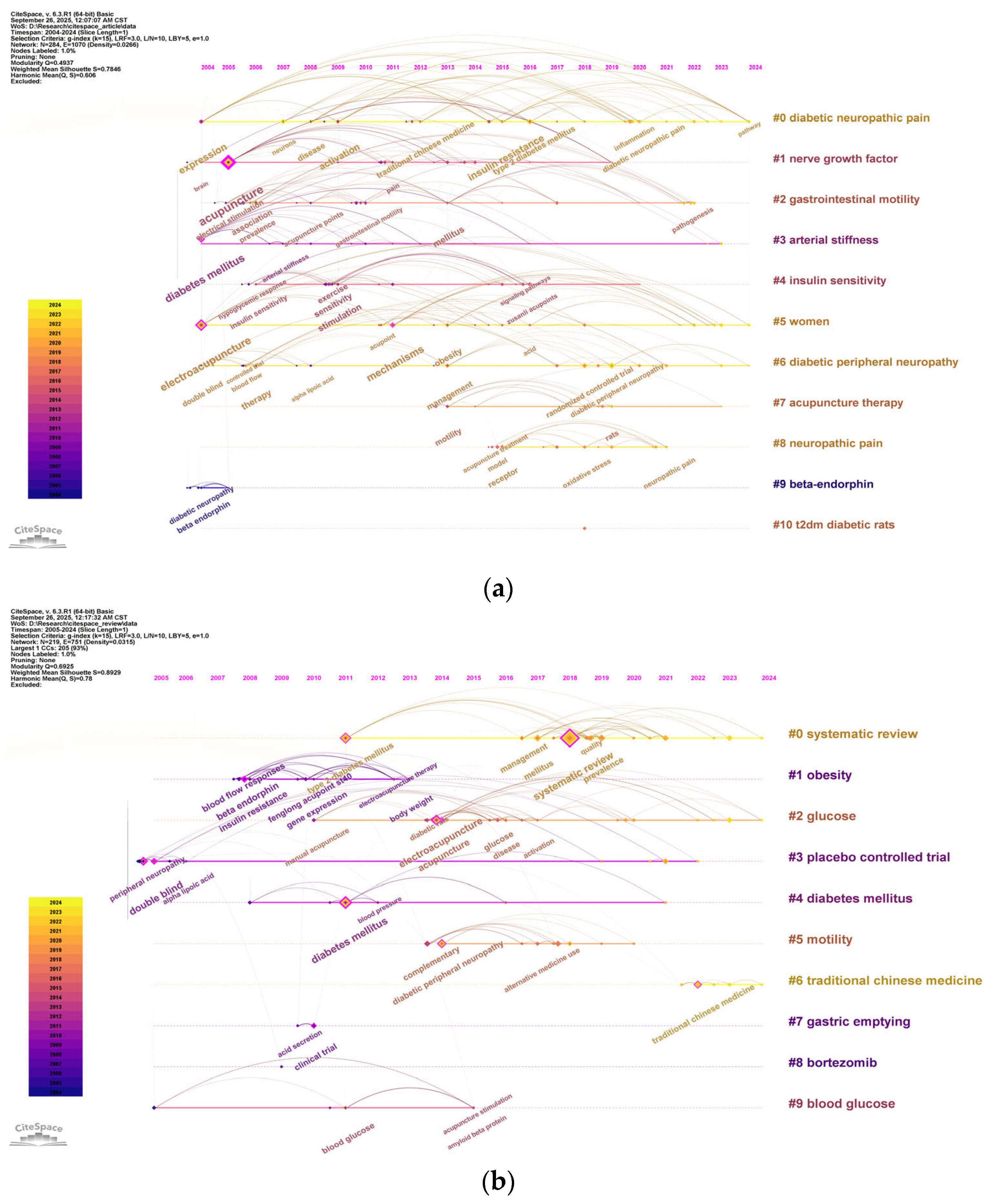
| Number | Contents |
|---|---|
| #1 | TS = (“Acupuncture” OR “Pharmaco acupuncture Treatment” OR “Electroacupuncture” OR “Electro-acupuncture” OR “Body Acupuncture” OR “Manual Acupuncture” OR “Auricular” OR “Auricular Acupuncture” OR “Auricular Needle” OR “Acupuncture Point” OR “Ear Acupuncture” OR “Warm Acupuncture” OR “needle warming moxibustion” OR “Moxibustion” OR “moxibustion” OR “Thermal moxibustion” OR “Acupoint Injection” OR “Catgut Embedding” OR “Catgut Implantation at Acupoint” OR “Embedding Thread” OR “Dry needle” OR “transcutaneous electrical acupoint stimulation” OR “Scalp acupuncture” OR “fire needle”) |
| #2 | TS = (“Diabetes mellitus” or “Diabetes *” or “Diabetic *” or “Diabetic mellitus”) |
| #3 | #1 AND #2 |
| Items | Rank | Name | Centrality | Year * | Publications |
|---|---|---|---|---|---|
| Country/region | 1 | People’s Republic of China | 0.45 | 2008 | 240 |
| 2 | United States of America | 0.52 | 2004 | 59 | |
| 3 | Taiwan (China) | 0.04 | 2004 | 34 | |
| 4 | South Korea | 0.09 | 2004 | 17 | |
| 5 | Germany | 0.38 | 2006 | 14 | |
| 6 | England | 0.3 | 2011 | 11 | |
| 7 | Italy | 0 | 2010 | 8 | |
| 8 | Japan | 0 | 2009 | 6 | |
| 9 | Sweden | 0.09 | 2008 | 5 | |
| 10 | Mexico | 0 | 2007 | 5 | |
| Institution | 1 | Changchun University of Chinese Medicine | 0.02 | 2009 | 28 |
| 2 | China Academy of Chinese Medical Sciences | 0.08 | 2008 | 25 | |
| 3 | Guangzhou University of Chinese Medicine | 0.1 | 2014 | 23 | |
| 4 | Beijing University of Chinese Medicine | 0.08 | 2013 | 21 | |
| 5 | China Medical University Taiwan | 0.12 | 2005 | 20 | |
| 6 | China Medical University Hospital—Taiwan | 0 | 2008 | 14 | |
| 7 | Huazhong University of Science and Technology | 0 | 2011 | 13 | |
| 8 | Institute of Acupuncture and Moxibustion | 0.01 | 2008 | 12 | |
| 9 | Shanghai University of Traditional Chinese Medicine | 0.03 | 2011 | 12 | |
| 10 | Nanjing University of Chinese Medicine | 0.16 | 2013 | 12 |
| Items | Rank | Name | Centrality | Year * | Publications/Count |
|---|---|---|---|---|---|
| Author | 1 | Chang, Shih-Liang | 0 | 2006 | 10 |
| 2 | Li, Meng-Yuan | 0 | 2021 | 10 | |
| 3 | Huang, Hai-Peng | 0 | 2021 | 8 | |
| 4 | Rong, Pei-Jing | 0 | 2014 | 7 | |
| 5 | Liu, Shi | 0 | 2013 | 7 | |
| 6 | Li, Shao-Yuan | 0 | 2014 | 5 | |
| 7 | Wang, Hong-Feng | 0 | 2021 | 5 | |
| 8 | Yao, Lin | 0 | 2021 | 5 | |
| 9 | Ma, Shi-Qi | 0 | 2021 | 5 | |
| 10 | Lee, Yu-Chen | 0 | 2011 | 4 | |
| Co-author | 1 | Chang, S.L. | 0.31 | 2004 | 43 |
| 2 | Moher, D. | 0.01 | 2019 | 32 | |
| 3 | Amer Diabet Assoc | 0.12 | 2013 | 31 | |
| 4 | Liang, F. | 0.04 | 2014 | 21 | |
| 5 | Tesfaye, S. | 0.04 | 2020 | 18 | |
| 6 | Garrow, A.P. | 0.04 | 2019 | 17 | |
| 7 | Chen, W. | 0.03 | 2014 | 16 | |
| 8 | Boultion, A.J.M. | 0.05 | 2005 | 16 | |
| 9 | Abuaisha, B.B. | 0.33 | 2004 | 16 | |
| 10 | Li, J. | 0.01 | 2021 | 15 |
| Rank | Co-Cited Journal | Year * | Count | Centrality | IF (2024) | JCR |
|---|---|---|---|---|---|---|
| 1 | Diabetes Care | 2006 | 181 | 0.15 | 14.8 | Q1 |
| 2 | Evidence-Based Complementary and Alternative Medicine | 2011 | 156 | 0.15 | 2.65 | Q3 |
| 3 | Acupuncture in Medicine | 2006 | 142 | 0.11 | 2.4 | Q2 |
| 4 | PLoS One | 2013 | 139 | 0.12 | 2.9 | Q1 |
| 5 | Diabetologia | 2004 | 123 | 0.13 | 8.4 | Q1 |
| 6 | Diabetes Research and Clinical Practice | 2006 | 106 | 0.05 | 6.1 | Q1 |
| 7 | Diabetes | 2009 | 101 | 0.13 | 6.2 | Q1 |
| 8 | Journal of Alternative and Complementary Medicine | 2010 | 86 | 0.06 | 2.3 | Q2 |
| 9 | American Journal of Chinese Medicine | 2008 | 83 | 0.08 | 4.8 | Q1 |
| 10 | Neuroscience Letters | 2004 | 79 | 0.15 | 2.5 | Q3 |
| Rank | Author | References | Citations | Centrality |
|---|---|---|---|---|
| 1 | Chen, C. | Acupuncture for type 2 diabetes mellitus: A systematic review and meta-analysis of randomized controlled trials [9]. | 19 | 0.01 |
| 2 | Cho, N.H. | IDF Diabetes Atlas: Global estimates of diabetes prevalence for 2017 and projections for 2045 [16]. | 16 | 0.02 |
| 3 | Dimitrova, A. | Acupuncture for the Treatment of Peripheral Neuropathy: A Systematic Review and Meta-Analysis [17]. | 15 | 0.01 |
| 4 | Bailey, A. | Acupuncture Treatment of Diabetic Peripheral Neuropathy in an American Indian Community [18]. | 15 | 0.01 |
| 5 | Pan, H. | “Adjusting internal organs and dredging channel” electroacupuncture treatment prevents the development of diabetic peripheral neuropathy by downregulating glucose-related protein 78 (GRP78) and caspase-12 in streptozotocin-diabetic rats [19]. | 14 | 0.03 |
| 6 | Feng, Y.Y. | Acupoint Therapy on Diabetes Mellitus and Its Common Chronic Complications: A Review of Its Mechanisms [20]. | 12 | 0.03 |
| 7 | Meyer-Hamme, G. | ACUDIN—ACUpuncture and laser acupuncture for treatment of DIabetic peripheral Neuropathy: A randomized, placebo-controlled, partially double-blinded trial [21]. | 9 | 0 |
| 8 | Meyer-Hamme, G. | Electrophysiologically verified effects of acupuncture on diabetic peripheral neuropathy in type 2 diabetes: The randomized, partially double-blinded, controlled ACUDIN trial [22]. | 9 | 0.02 |
| 9 | Wang, X. | Electroacupuncture Alleviates Diabetic Peripheral Neuropathy by Regulating Glycolipid-Related GLO/AGEs/RAGE Axis [23]. | 8 | 0.01 |
| 10 | Chang, S.L. | Enhanced insulin sensitivity using electroacupuncture on bilateral Zusanli acupoints (ST 36) in rats [24]. | 8 | 0.02 |
| Rank | Keyword | Centrality | Year * | Count |
|---|---|---|---|---|
| 1 | acupuncture | 0.73 | 2005 | 71 |
| 2 | electroacupuncture | 0.25 | 2011 | 45 |
| 3 | diabetes mellitus | 0.33 | 2007 | 36 |
| 4 | systematic review | 0.1 | 2018 | 34 |
| 5 | diabetic peripheral neuropathy | 0.04 | 2018 | 29 |
| 6 | mellitus | 0.13 | 2013 | 26 |
| 7 | expression | 0.03 | 2013 | 21 |
| 8 | insulin resistance | 0.06 | 2011 | 20 |
| 9 | type 2 diabetes mellitus | 0.03 | 2021 | 19 |
| 10 | prevalence | 0.02 | 2006 | 18 |
| 11 | mechanisms | 0.08 | 2011 | 17 |
| 12 | management | 0.05 | 2013 | 17 |
| 13 | activation | 0.05 | 2009 | 16 |
| 14 | stimulation | 0.16 | 2009 | 13 |
| 15 | traditional Chinese medicine | 0.01 | 2022 | 11 |
| 16 | randomized controlled trial | 0.02 | 2020 | 11 |
| 17 | glucose | 0.02 | 2015 | 11 |
| 18 | pain | 0.03 | 2011 | 11 |
| 19 | motility | 0.02 | 2013 | 10 |
| 20 | diabetic neuropathic pain | 0.01 | 2020 | 10 |
Disclaimer/Publisher’s Note: The statements, opinions and data contained in all publications are solely those of the individual author(s) and contributor(s) and not of MDPI and/or the editor(s). MDPI and/or the editor(s) disclaim responsibility for any injury to people or property resulting from any ideas, methods, instructions or products referred to in the content. |
© 2025 by the authors. Licensee MDPI, Basel, Switzerland. This article is an open access article distributed under the terms and conditions of the Creative Commons Attribution (CC BY) license (https://creativecommons.org/licenses/by/4.0/).
Share and Cite
Gu, T.; Nie, Y.; Yang, H. Mapping Global Research Landscapes of Acupuncture for Diabetes Mellitus: A 20-Year Bibliometric Study (2004–2024). Healthcare 2025, 13, 2468. https://doi.org/10.3390/healthcare13192468
Gu T, Nie Y, Yang H. Mapping Global Research Landscapes of Acupuncture for Diabetes Mellitus: A 20-Year Bibliometric Study (2004–2024). Healthcare. 2025; 13(19):2468. https://doi.org/10.3390/healthcare13192468
Chicago/Turabian StyleGu, Tianyu, Yuhan Nie, and Huayuan Yang. 2025. "Mapping Global Research Landscapes of Acupuncture for Diabetes Mellitus: A 20-Year Bibliometric Study (2004–2024)" Healthcare 13, no. 19: 2468. https://doi.org/10.3390/healthcare13192468
APA StyleGu, T., Nie, Y., & Yang, H. (2025). Mapping Global Research Landscapes of Acupuncture for Diabetes Mellitus: A 20-Year Bibliometric Study (2004–2024). Healthcare, 13(19), 2468. https://doi.org/10.3390/healthcare13192468







